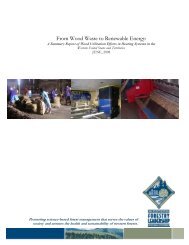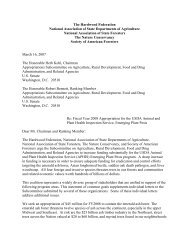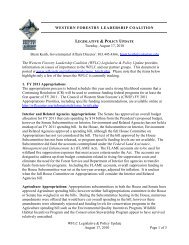Emission Controls for Small Wood-Fired Boilers - Western Forestry ...
Emission Controls for Small Wood-Fired Boilers - Western Forestry ...
Emission Controls for Small Wood-Fired Boilers - Western Forestry ...
You also want an ePaper? Increase the reach of your titles
YUMPU automatically turns print PDFs into web optimized ePapers that Google loves.
4.4 Equipment Sensors<br />
Many wood boilers are equipped with internal sensors that provide real time in<strong>for</strong>mation about some<br />
aspect of the combustion process to an automated control system. In<strong>for</strong>mation from these sensors helps<br />
the system self‐regulate with the intelligence they provide. Sensors are frequently used to measure<br />
pressure drop across a mechanical collector or baghouse, opacity in the exhaust stack (with smoke<br />
density meters), oxygen level in the combustion chamber and/or exhaust stack, and temperature in the<br />
combustion chamber and/or exhaust stack.<br />
4.5 Automatic Ash Removal<br />
Bottom ash, or ash collected at the bottom of the combustion chamber, can become re‐suspended and<br />
carry over into the exhaust, thereby increasing particulate matter emissions. Automatic ash removal can<br />
ensure frequent bottom ash removal. This may be especially useful if burning a high ash content fuel.<br />
4.6 Raking Grates as Needed<br />
In most direct burn combustion systems, biomass is combusted on grates. Ash will accumulate on these<br />
grates. If left to accumulate, this can lead to clinker <strong>for</strong>mation and limit under‐fire airflow thereby<br />
reducing combustion efficiency. Raking the grates reduces this problem.<br />
4.7 Combustion Efficiency Testing<br />
Combustion efficiency testing is a way to quantify the degree of combustion completeness, not the overall<br />
thermal efficiency (heat input divided by heat output). One method <strong>for</strong> measuring combustion efficiency<br />
is by measuring carbon monoxide (CO) and carbon dioxide (CO 2 ) concentrations in the boiler exhaust<br />
with a hand‐held portable analyzer.<br />
CO is an indicator of the level of gaseous air toxics in boiler exhaust and there<strong>for</strong>e a good surrogate <strong>for</strong><br />
gaseous air toxics. The relationship between CO and carbon dioxide (CO 2 ) concentrations provides an<br />
indication of the degree combustion completeness and is there<strong>for</strong>e appropriate <strong>for</strong> the levels of all<br />
emissions in boiler exhaust.<br />
Vermont and Rhode Island implemented a permit condition requiring measurement of both CO and CO 2<br />
in the exhaust gas to determine combustion efficiency. Combustion efficiency is determined using this<br />
equation, taken from a Vermont air pollution control permit:<br />
Equation 1<br />
CE<br />
CO<br />
CO + CO<br />
2<br />
(%) = × 100<br />
2<br />
Where:<br />
CE = Combustion efficiency,<br />
CO 2 = % by volume of carbon dioxide in the flue gas, and<br />
CO = % by volume of carbon monoxide in the flue gas.<br />
Compliance is demonstrated when the combustion efficiency is calculated to be equal to or greater than<br />
99%. A representative number of measurements should be taken given the broad range of operating<br />
conditions that can occur in a given biomass boiler.<br />
Resource Systems Group, Inc.<br />
<strong>Emission</strong> Control Technologies <strong>for</strong> <strong>Small</strong> <strong>Wood</strong>‐<strong>Fired</strong> <strong>Boilers</strong><br />
6 May 2010 Page 14










